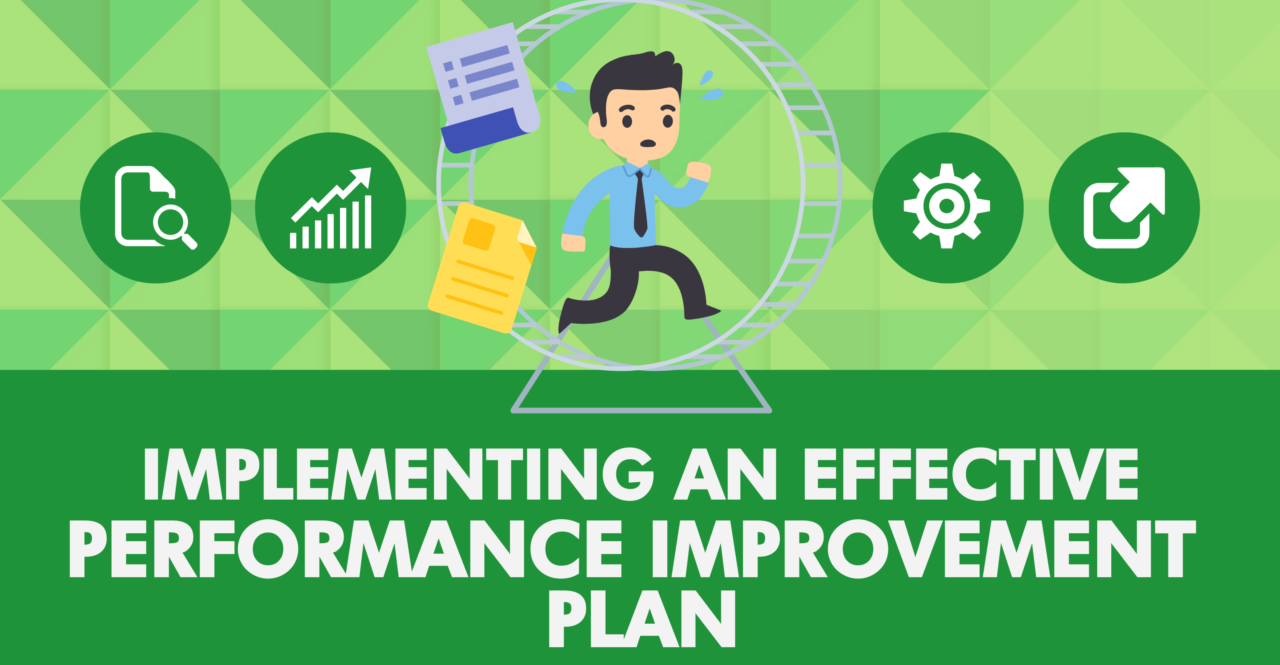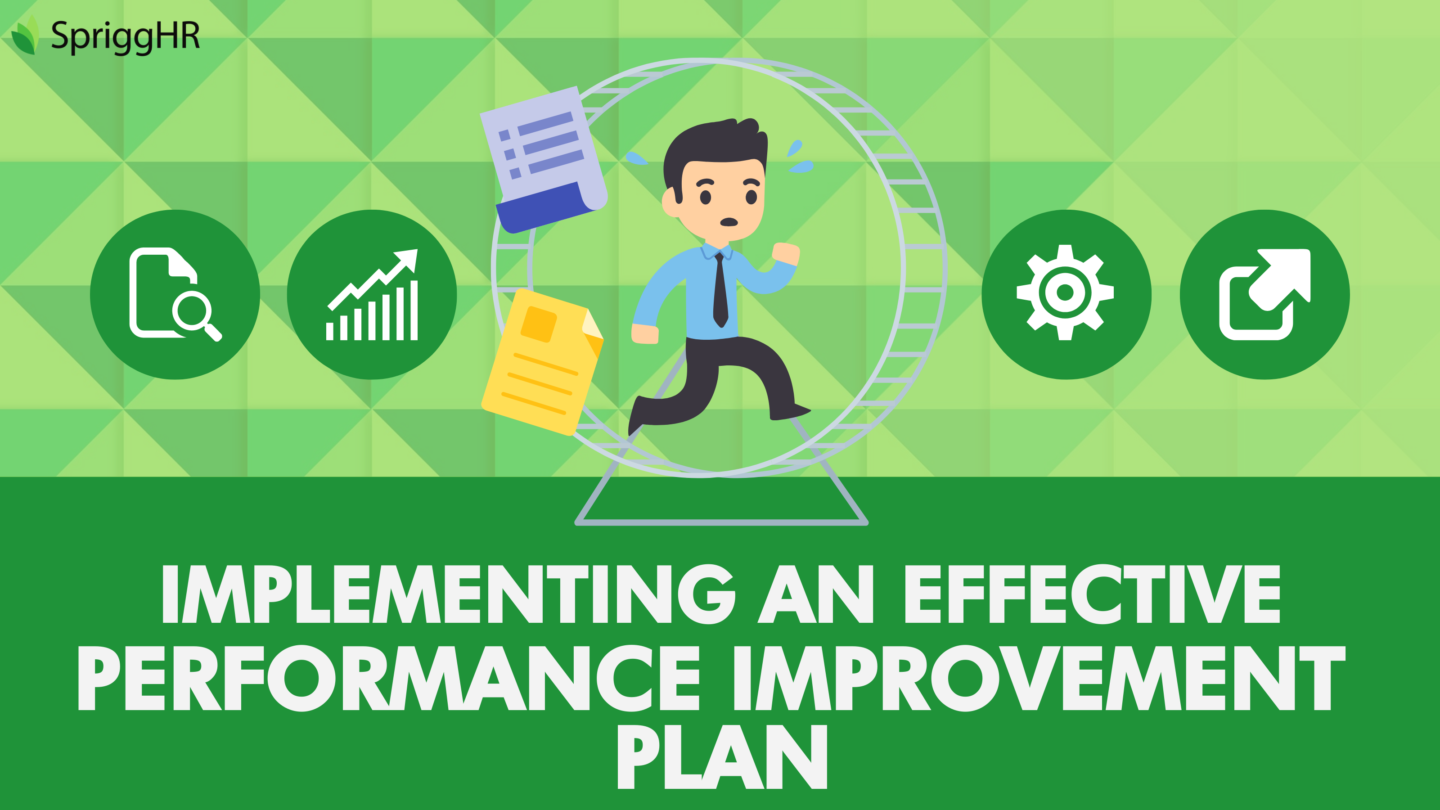
Implementing an Effective Performance Improvement Plan
If executed properly, an effective performance improvement plan can be the business tool that consistently resolves workplace productivity issues in your organization and can even work to help the most unlikely employee to succeed.
The Performance Improvement Plan and Its Importance
The impact of an under-performing employee isn’t limited to their manager and coworkers. Their behaviour can start a domino effect that can be felt by the entire team and company. As a result, company morale becomes tainted by frustration, wasted time, and exhaustion.
Part of every manager’s working experience involves dealing with employees who are under-performing. Whether they are not meeting job requirements or are exhibiting behaviours not in line with company expectations, the manager will eventually reach a point where they have no choice but to act in order to change the situation.
This is where a formal Performance Improvement Plan (PIP) comes into play. While, at first glance, firing the employee seems like the most logical move, HR and managers should first consider using a performance improvement plan to try and remedy the situation, providing the at-risk employee with the necessary directions for completing specific goals and working their way back up to success.
A performance improvement plan is designed to facilitate constructive discussion between a staff member and their supervisor, aiming to clarify the exact work performance and behaviour that requires improvement. It is implemented at the discretion of the supervisor when it becomes necessary to help an employee improve their performance.
The process involves identifying the root causes of poor performance, outlining the clear expectations for improvement, and giving the staff member a chance to remedy their shortcomings. Ultimately, performance improvement plans could not only save the time and costs that are lost in termination and re-hiring, but also can help to create a culture of performance accountability for employees and their supervisors.
When Are Performance Improvement Plans Useful?
The primary benefit of a performance improvement plan is its role in illustrating to an under-achieving employee that their current challenges and long-term goals are understood, and that the organization is there to take an active role in supporting them. Staff members are much more likely to be engaged, productive, and successful, when they have a clear understanding of what their organization expects of them and their work efforts. Performance improvements plans work to outline in detail the specific issues or behaviours that are causing problems for the employee’s success, and also stipulates the corrective actions they should take to improve, and which resources are available to offer support.
PIPs are not exclusive to employees who are not meeting their current requirements. They can also be useful for staff members who feel unfulfilled in their roles altogether, increasing their overall mobility and allowing them to transition into higher-level roles or move laterally into roles that they will be more satisfied in.
As a rule of thumb, performance improvement plans are the most useful and best implemented when you recognize that an employee is struggling. Whether their productivity has notably decreased, or they have begun to take more time off or seem less motivated and engaged in their communication, many managers are able to identify when an employee has become disengaged from their work.
Performance improvement plans should be implemented when there is a clear trend in an employee’s poor performance, and positive change and improvement is necessary.

How to Create an Effective Performance Improvement Plan
The goal of any performance improvement plan should never be to document an underperforming employee’s performance in order to make firing easier. While PIPs can serve as useful records for employees, supervisors should always treat them as a provided opportunity for their struggling staff members to work towards success.
Improving the Effectiveness of Performance Improvement Plans
Maintaining open lines of communication in performance improvement plans is necessary, and the goal of seeking a suitable solution for both the organization and the employee should be regularly stipulated. Some strategies to improve the overall effectiveness of a performance improvement plan include:
- Listening to the employee and providing them with the opportunity to respond to any of your points of concern. The performance improvement plan is not an excuse to lecture – it is a collaborative process, aiming to decrease the potential for an employee to feel disengaged or misunderstood.
- Paring down to the cause of any issues, asking questions to find the root of the issue. This could include questions relating to the employee’s perception of their potential in the company, their readiness for a different or more challenging role, whether personal issues are influencing their performance, and so on. The issue raised should be specific, supported by specific examples, to ensure the employee understands the opportunities and changes that are needed.
- Focusing on the positive and emphasizing their valuable contributions to the company. Give as much attention to finding ways to improve on these positives as you do stress the negatives, so they don’t feel bombarded with criticism.
- Outlining a clear path so they can understand their goals and the actions they need to take to meet behavioural and performance-based expectations. By being specific in outlining their goals, the more likely they are to obtain them. Vague goals can frustrate employees further.
- Regularly reviewing their progress. By tracking the employee’s progress and touching base regularly, the employee is more likely to stay motivated in their improvement efforts and will also appreciate being given a chance to talk about any concerns that have arisen. All encounters should focus on the progress of their efforts, and the employee should be allowed to comment on their improvements and ask questions for further clarification.
Recognizing the Risks of Performance Improvement Plans
Development conversations are never easy for either party. Even the best manager with the best method of delivering hard-to-swallow messages with respect, care, concern, and support, always runs the risk of facing pushback from defensive employees.
This Forbes article provides insight into the perception many employees have on the entire performance improvement plan process. Many feel it is simply a formality that occurs before the eventual termination of employment, and that being placed on a PIP means you are one step away from being terminated. Performance improvements plans should not be viewed as an opportunity given to supervisors to exert “power and control, letting an uppity employee know who’s boss.” The parting message of PIPs should not be a warning over the control managers have in the livelihood of their employees, but rather a reiteration of their role as a supportive and concerned figure in the success of every individual staff member.
The conversation is never simple, however, there are a few methods that can be used to ease the sting of performance improvement plans and reduce the potential for employees to view them as they are described in the article mentioned above.
1. Document behaviours and accounts of employee performance. This helps to remove any vagueness from the conversation. By commenting on specific behaviours and examples, employees are less likely to feel overwhelmed by unclear accusations.
2. Ensure you are addressing a trend in performance. Every employee should be striving for ongoing development, even top performers, but every staff member is likely to see a formal performance improvement plan as a substantial event in their career. Before proceeding with any PIP, managers and supervisors should be absolutely certain that poor performance or undesirable behaviours are actual trends, and not simply anomalies that every employee will experience from time to time.
3. Keep it focused on performance. Personal attacks on employees should be avoided at all costs. No matter the personal relationship between a supervisor and an employee, PIPs should always be focused solely on results and performances, and should not be implemented or driven by external, personal motives.
Performance Improvement Plan Process
Any performance improvement plan should be reviewed by several people, including a manager’s own supervisor and an HR representative, for objective feedback and approval, before being implemented. This ensures that every employee experiences consistent and fair treatment across all departments in an organization.
As a general structure, the following six items should be points of review for the PIP conversation:
- State the exact performance that must be improved, being specific and citing examples.
- State the level of the work performance expectation, and that it must be performed on a consistent basis.
- Identify and specify the support and resources that you will provide to assist the employee in their success.
- Communicate your plan for providing feedback to the employee, specifying meeting times, with whom and how often, as well as the measurements you will consider in evaluating their progress.
- Specify possible consequences if the performance standards you are establishing in the official PIP are not met.
- Provide sources of additional information and supporting resources, such as employee handbooks, training sessions, and any other resource that can be helpful in the employee’s efforts to improve their performance.
Final Thoughts
Formal performance improvement plans are best implemented for employees who appear to have the greatest potential for improvement. By framing our understanding of PIPs under the lens of improvement, rather than reprimanding poor behaviour, the reputation of this business practice can drastically improve.
In order to ensure an employee’s ultimate success, the performance improvement plan should be realistic, fair, and clearly specify the required goals and means for accomplishing them. It should also be approved by upper management and HR, ensuring fairness across all levels of an organization. When used properly, performance improvements plans have the potential to transform a struggling employee into an organization’s top performer.




